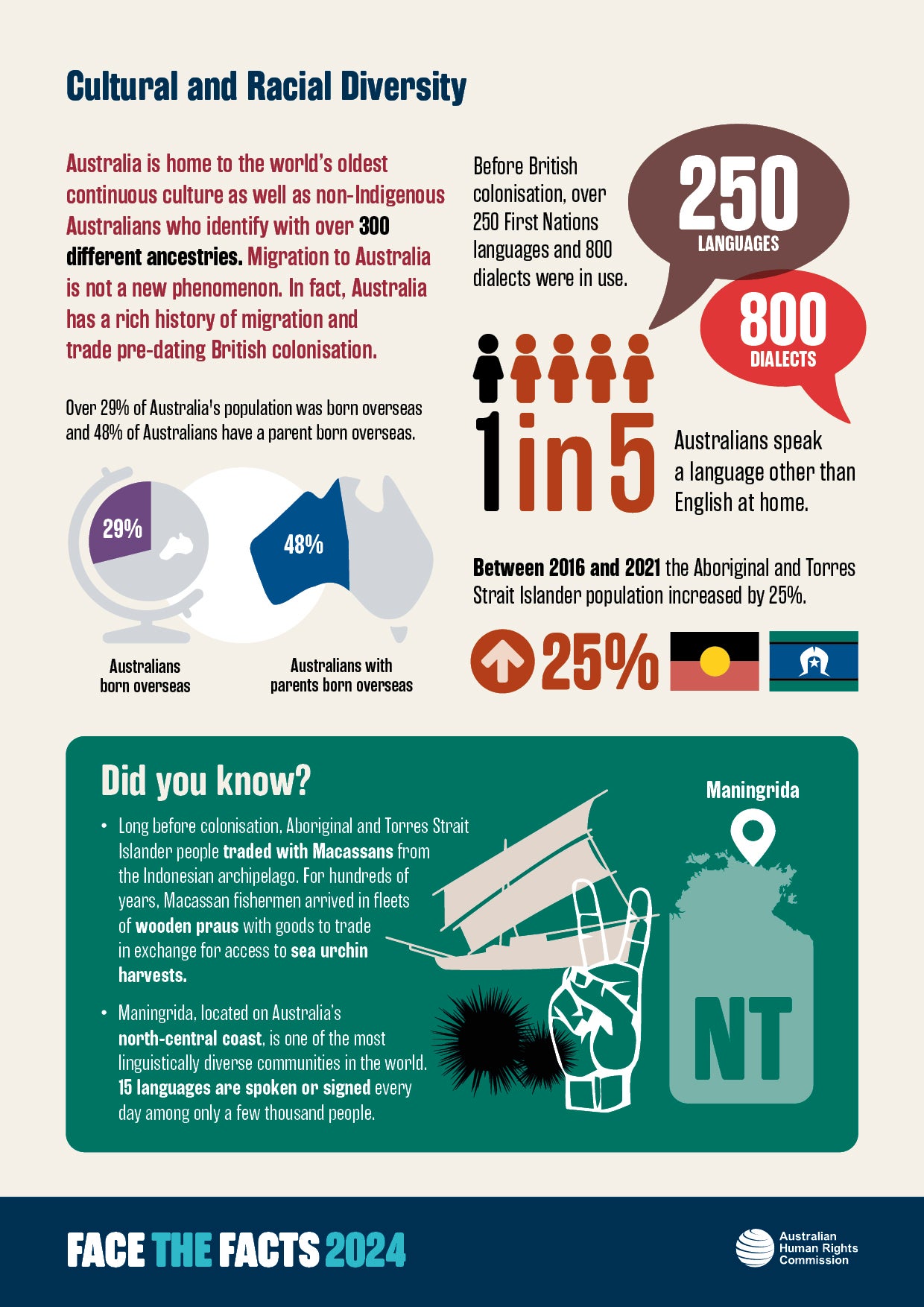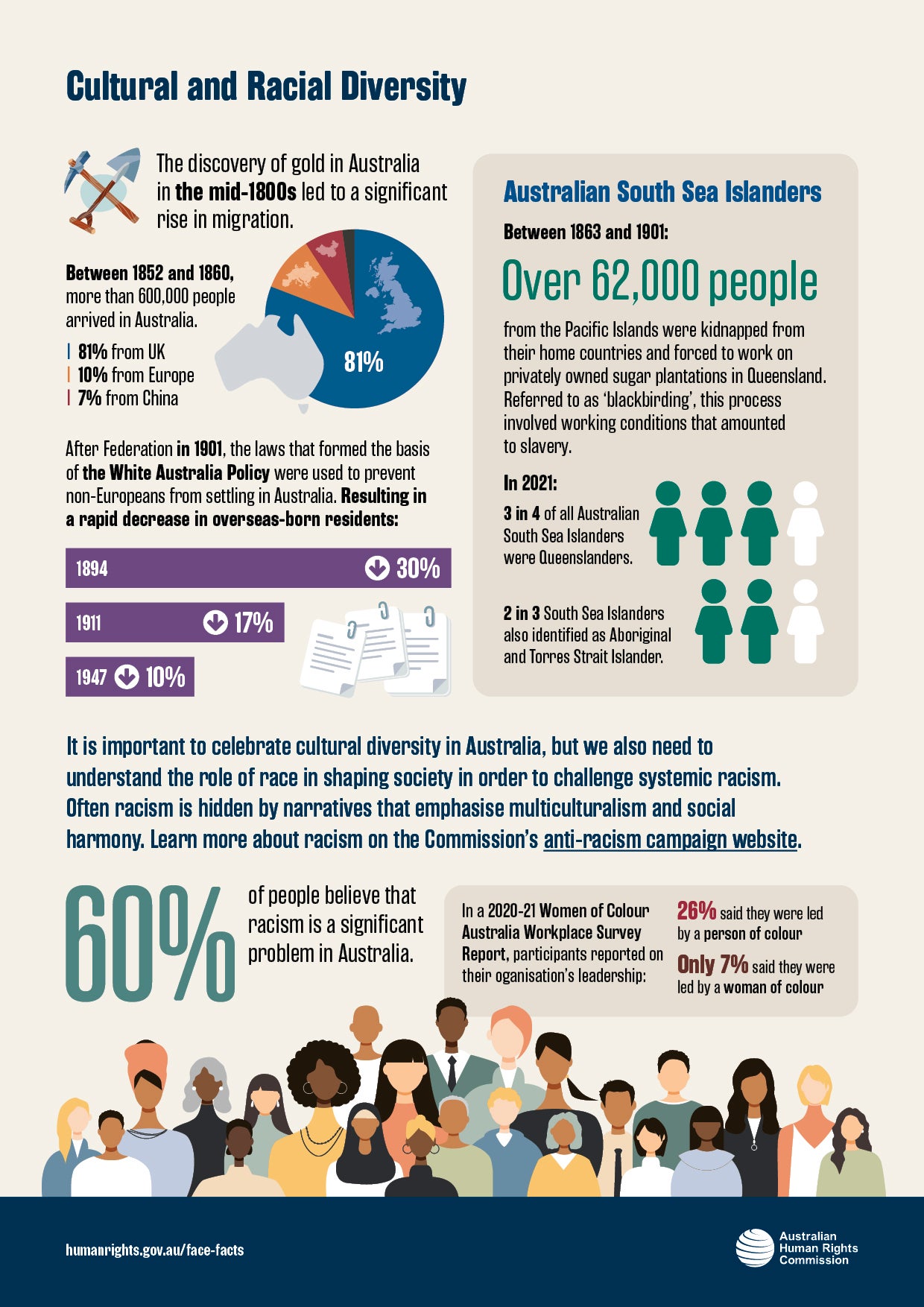Statistics about Cultural and Racial Diversity
09/10/2024
Australia is home to the world's oldest continuous culture as well as non-Indigenous Australians who identify with over 300 different ancestries. Migration to Australia is not a new phenomenon. In fact, Australia has a rich history of migration and trade pre-dating British colonisation.[1]
Cultural and racial diversity in Australia
- Over 29% of Australia's population was born overseas and 48% of Australians have a parent born overseas.[2]
- It is estimated that before British colonisation, over 250 First Nations languages and 800 dialects were in use.[3]
- More than 1 in 5 Australians speak a language other than English at home.[4]
- Between 2016 and 2021 the Aboriginal and Torres Strait Islander population increased by 25%.[5]
Did you know?
- Long before the colonisation, Aboriginal and Torres Strait Islander people traded with Macassans from the Indonesian archipelago. For hundreds of years, Macassan fishermen arrived in fleets of traditional wooden praus with goods to trade in exchange for access to annual sea urchin harvests.[6]
- Maningrida, located on Australia’s north-central coast, is one of the most linguistically diverse communities in the world. 15 languages are spoken or signed every day among only a few thousand people.[7]
- The discovery of gold in Australia in the mid-1800s led to a significant rise in migration.
- Between 1852 and 1860, more than 600,000 people arrived in Australia, with 81% from the UK, 10% from Europe, and 7% from China.[8]
- After Federation in 1901, the laws that formed the basis of the White Australia Policy were used to prevent non-Europeans from settling in Australia. This resulted in a rapid decrease in overseas-born residents from almost 30% in 1894 to around 17% in 1911, reaching a low of 10% in 1947.[9]
Australian South Sea Islanders
- Between 1863 and 1901, over 62,000 people from the Pacific Islands were kidnapped from their home countries and forced to work on privately owned sugar plantations in Queensland. Referred to as 'blackbirding', this process involved working conditions that amounted to slavery.[10]
- In 2021, 3 in 4 of all Australian South Sea Islanders were Queenslanders.
- 2 in 3 South Sea Islanders also identified as Aboriginal and Torres Strait Islander.[11]
Racism and discrimination
It is important to celebrate cultural diversity in Australia, but we also need to understand the role of race in shaping society in order to challenge systemic racism. Often racism is hidden by narratives that emphasise multiculturalism and social harmony. Learn more about racism on the Commission's anti-racism campaign website.
- Around 60% of people believe that racism is a significant problem in Australia.[12]
- In a 2020-21 Women of Colour Australia Workplace Survey Report, 26% of respondents said that their organisation was led by a person of colour and only 7% said that their organisation was led by a woman of colour.[13]
References
- [1] Australian Bureau of Statistics, Understanding and using Ancestry data: Explaining the different ways ancestry data can be used and collected (ABS Website, 28 June 2022).
- [2] Australian Bureau of Statistics, Australia’s Population by Country of Birth (ABS Website, 26 April 2021).
- [3] National Archives of Australia, Dispossession and revival of Indigenous languages.
- [4] Australian Bureau of Statistics, Cultural Diversity of Australia (ABS Website, 20 September 2022).
- [5] Australian Bureau of Statistics, Understanding change in counts of Aboriginal and Torres Strait Islander Australians: Census (ABS Website, 4 April 2023).
- [6] Department of Immigration and Border Protection (Cth), A History of the Department of Immigration: Managing Migration in Australia (June 2017).
- [7] Jill Vaughan, Meet the remote Indigenous community where a few thousand people use 15 different languages (5 December 2018) The Conversation.
- [8] The Guardian, How immigration changed Australia – an interactive journey through history (30 January 2023) <>.; Department of Immigration and Border Protection (Cth), A History of the Department of Immigration: Managing Migration in Australia (June 2017).
- [9] Department of Immigration and Border Protection (Cth), A History of the Department of Immigration: Managing Migration in Australia (June 2017) <>; Emil Jeyaratnam, Twelve charts on race and racism (28 November 2018) The Conversation.
- [10] Ibid; Jeff Sparrow, Friday essay: a slave state – how blackbirding in colonial Australia created a legacy of racism (5 August 2022) The Conversation.
- [11] Queensland Government Statistician’s Office, Australian South Sea Islanders in Queensland, Census 2021 (2022) The State of Queensland (Queensland Treasury).
- [12] Andrew Markus, Mapping Social Cohesion (Scanlon Foundation Report, 2021) 11.
- [13] Women of Colour Australia, Workplace Survey Report 2020-21 (Report, 2021) 5.
Downloads
- Cultural and Racial Diversity Face the Facts with references PDF (358 KB)
- Cultural and Racial Diversity Face the Facts no references PDF (538 KB)
- Cultural and Racial Diversity Face the Facts Word (1.06 MB)
Further Reading
- Understand Why Racism is a Problem?
- Explore Who Experiences Racism?
- Explore human rights teaching resources relating to racism
- Understand the Australian Human Right's Commission work on Race Discrimination
- Review the Australian Human Rights Commission's Anti-Racism Framework
- Commit to learning to address racism in a meaningful way on the It Stops With Me website


